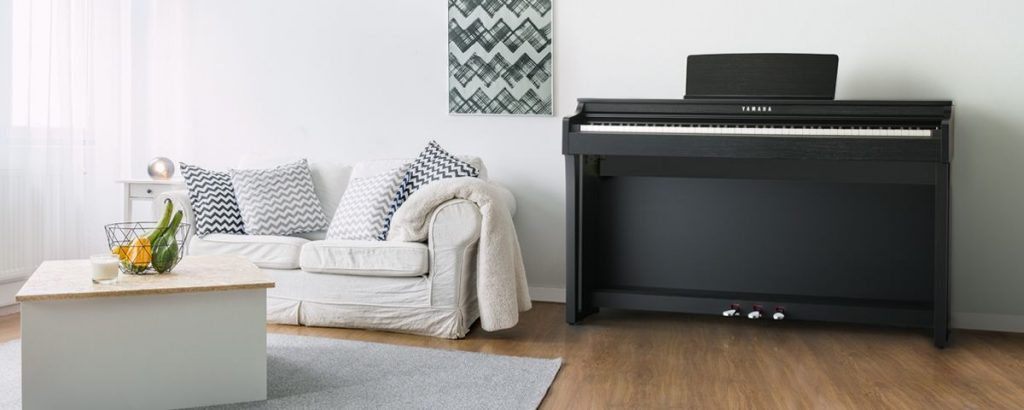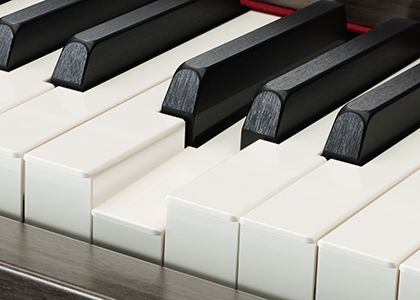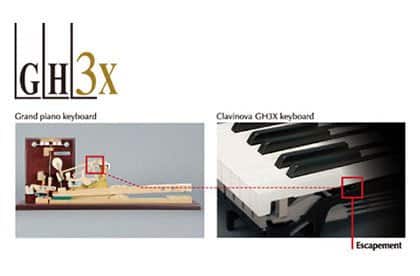Digital Piano Keyboard VS The Acoustic Piano
Which is a better for a beginner piano player, an acoustic piano or is a digital piano keyboard a better option? This is a question asked allot at Pats Music Store.
In brief, the answer depends on the musician’s goal and budget. For unlike other instrumentalists, many piano players will never own their ideal musical instrument. And for good reason. In reality the ideal piano to learn and develop the finite skill needed to be a concert pianist, is a 9ft Concert Grand Piano. (Priced at over $200k).
Obviously it is not realistic or practical for most people to own a 9ft Concert Grand Piano. Comparatively, anything less than that is inevitably a compromise and so too are digital pianos.
Even so, many of the top brand digital pianos come freakishly close in sound and feel to an acoustic piano. Due to great advancements in technology over the last decade, many Piano Keyboards make a convincing substitute.

Piano Keyboard Facts
With this in mind, here are some terms you may come across when researching digital pianos and what they mean;
Touch sensitive or touch responsive keys:

With sensors under the keys or inside the key mechanism, a digital piano responds to how hard of soft the keys are struck. As a result, a harder key strike triggers the relevant louder sample, taken from a real piano. In contrast, a softer strike of the key, triggers a sample taken from a softer piano keyboard strike.

Weighted keys or Graded Hammer Action (GHA):
The keys on an acoustic piano are heavy to press because they are attached to the hammers that strike the strings. The hammers that strike the bass strings are bigger and the ones that hit the treble, or higher strings are smaller. In a digital Piano the ‘action’ mechanism is created to feel like it’s moving hammers by using little weights. We know this as weighted keys. Most digital pianos have heavier weights in the base and lighter in the treble and they call this Graded Hammer Action.
Polyphony:
Essentially this is the processing power, i.e how many samples are able to play at one time, before the memory runs out and the sounds become compromised. Using the piano sound for example, the player can play up to 10 notes at a time (10 fingers). They may even have 2 instruments on at one time, such as Piano and Strings. This means 20 sounds play at one time. If the player holds down the sustain pedal the notes will then play on top of each other. Most good digital pianos have over 129 note polyphony. The player would have to play 11 X 10 note chords with using 2 sounds at once plus the sustain before the sound start to cut out. It’s very unlikely a player would do this.
Sound modelling technology:
Some digital piano manufactures now use ‘sound modelling technology’ either to create the entire sound or add to the digitally sampled sound. SMT gives the piano sound more detail and dimension. Put simply SMT observes and maps out the behaviour of sound waves and designs detailed algorithms to recreate the sound waves. SMT can gives us ‘after sound’ sounds such as sympathetic resonance; Where, on an acoustic piano, the strings resonate in sympathy to other strings being struck. SMT can calculate harmonics, naturally occurring overtones in instruments. SMT can recreate cabinet resonance; the woody sound of the piano body vibrating. And after touch; the sound of the damper dropping back on the sting. Sound Modelling Technology makes digital pianos more realistic than they have ever been.
Digital Piano Brands:
The three most well known brands for Digital Piano Keyboards are Yamaha, Kawai and Roland. The Casio Celviano pianos are also becoming more popular. Each digital piano replicates different acoustic pianos. The Yamaha for example replicates the Yamaha CFIII and Bosendorfer Concert grand pianos. The Roland Replicates the most elite European Piano, but neither Roland or our Piano Shop Blog but can name it for legal reasons.
Benefits of going digital:
There are many benefits of a digital piano. The first is the ability to play silently with headphones. Also a Digital Piano does not need tuning. Furthermore, a simple connection to a computer, allows use with record software or many of the apps now available. Some digital pianos also have Bluetooth, for use with iPods. Models such as the Yamaha CSP range take piano playing to another level by incorporating auto-accompaniment, lessons, Karaoke, multi-track recording and microphone input. They’re like a musical home-entertainment-system as well as a piano.